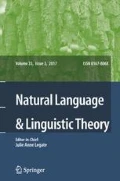Abstract.
The Cantonese ‘coverb’ construction, a serial verb construction in which the first verb (the ‘coverb’) has a preposition-like meaning and function, presents a challenge for theories of wh-dependencies and island constraints. Coverbs resist extraction of their objects by topicalization or relativization, a fact which has often been explained in terms of a preposition-stranding constraint in accounts of similar facts in Mandarin. However, Cantonese coverbs display the morphosyntactic properties of verbs, suggesting that they cannot be prepositions. In this paper, we propose that coverbs are verbs, and that the relevant extraction constraint is a kind of adjunct island constraint. This proposal is supported with experimental evidence from a sentence judgment task. Two key findings are as follows: (1) listeners judged extraction from a coverb phrase as significantly less acceptable than extraction from a simple clause; (2) listeners judged sentences both with and without aspectual marking (verbal morphosyntax) on the coverb as highly acceptable. Together, these findings support our proposal that coverbs are verbs (not prepositions) and that coverb phrases form a kind of adjunct island. However, we show that existing adjunct island conditions (such as the CED) are not adequate to account for our data. Following Hawkins’ (1999) processing-based theory of filler-gap dependencies, we propose a simple, language-specific formulation of the extraction constraint, and we argue that this constraint is more generally motivated by a processing principle called Avoid Competing Subcategorizers – one of the same principles that motivates preposition-stranding constraints in other languages. Thus, although object extraction is prohibited by a kind of adjunct island constraint, the function of the constraint in processing efficiency is similar to that of a preposition-stranding constraint.
Similar content being viewed by others
References
Andrews, Avery D. and Christopher D. Manning. 1999. Complex Predicates and Information Spreading in LFG, CSLI, Stanford.
Baker Mark C (2003). Lexical Categories: Verbs, Nouns and Adjectives. Cambridge University Press, Cambridge
Baltin, Mark. (1978). Constraints on Construal, Ph.D. dissertation, MIT, Cambridge, MA.
Baltin Mark R and Postal Paul M (1996). ‘More on Reanalyses Hypotheses’. Linguistic Inquiry 27: 127–145
Bard Ellen G, Robertson Dan and Sorace Antonella (1996). ‘Magnitude Estimation of Linguistic Acceptability’. Language 72: 32–68
Carstens Vicki (2002). ‘Antisymmetry and Word Order in Serial Constructions’. Language 78: 3–50
Chan Alice Yin Wa (2000). ‘Chinese Serial Verb Constructions with Experiential Aspect Marker-Syntactic Representations and Semantic Interpretations’. Communications of COLIPS 10: 69–97
Chomsky Noam (1986). Barriers. MIT Press, Cambridge, MA
Collins Chris (1997). ‘Argument Sharing in Serial Verb Constructions’. Linguistic Inquiry 28: 461–497
Cowart Wayne (1997). Experimental Syntax. Sage Publications, Thousand Oaks, CA
Croft William (1991). Syntactic Categories and Grammatical Relations. University of Chicago Press, Chicago
Culicover Peter W and Jackendoff Ray S (1997). ‘Semantic Subordination Despite Syntactic Coordination’. Linguistic Inquiry 28: 195–218
Culicover Peter W and Jackendoff Ray S (2005). Simpler Syntax. Oxford University Press, Oxford
Dai John Xiang-ling (1990). ‘Syntactic Constructions in Serial Verb Expressions in Chinese’. In: Joseph, B and Zwicky, A (eds) When Verbs Collide: Papers from the 1990 Ohio State Mini-Conference on Serial Verbs, Department of Linguistics, pp 316–339. The Ohio State University, Columbus
Déchaine, Rose-Marie. 1993a. ‘Serial Verb Constructions’, in J. Jacobs et al. (eds.), Syntax: An International Handbook of Contemporary Research, Walter de Berlin, pp. 799–825.
Déchaine, Rose-Marie. 1993b. Predicates Across Categories, Ph.D. dissertation, University of Massachusetts at Amherst.
Finney Malcolm A (1992). ‘The Theta Criterion and Argument-Sharing in Serial Verb Constructions’. Cahiers Linguistiques d’Ottawa 20: 26–43
Francis Elaine J (2005). ‘Syntactic Mimicry as Evidence for Prototypes in Grammar’. In: Mufwene, S.S., Francis, E.J. and Wheeler, R.S. (eds) Polymorphous Linguistics: Jim McCawley’s Legacy, pp 161–181. MIT Press, Cambridge, MA
Francis Elaine J and Matthews Stephen (2005). ‘A Multi-Dimensional Approach to the Category ‘Verb’ in Cantonese’. Journal of Linguistics 41: 269–305
Frazier Lyn, Clifton Charles and Randall Janet (1983). ‘Filling Gaps: Decision Principles and Structure in Sentence Comprehension’. Cognition 13: 187–222
Goldberg Adele E (2006). Constructions at Work: The Nature of Generalization in Language. Oxford University Press, Oxford
Hagemeijer Tjerk (2001). ‘Underspecification in Serial Verb Constructions’. In: Corver, N. (eds) Semi-lexical Categories: The Function of Content Words and the Content of Function Words, pp 415–451. Mouton de Gruyter, Berlin
Hawkins John A (1999). ‘Processing Complexity and Filler-Gap Dependencies Across Grammars’. Language 75: 244–285
Hawkins John A (2004). Efficiency and Complexity in Grammars. Oxford University Press, Oxford
Hopper Paul J. and Thompson Sandra A. (1984). ‘The Discourse Basis for Lexical Categories in Universal Grammar’. Language 60: 703–752
Hornstein Norbert and Weinberg Amy (1981). ‘Case Theory and Preposition Stranding’. Linguistic Inquiry 12: 55–91
Huang C. T. James. 1982. Logical Relations in Chinese and the Theory of Grammar, Ph.D. dissertation, MIT, Cambridge, MA.
Huang C.T. (1998). Logical Relations in Chinese and the Theory of Grammar. Publishing, New York
Jones Charles. 1987. ‘P for Proper Governor’. West Coast Conference on Formal Linguistics 115–130
Keenan Edward and Comrie Bernard (1977). ‘Noun Phrase Accessibility and Universal Grammar’. Linguistic Inquiry 8: 63–99
Koopman, Hilda. (1984). The Syntax of Verbs. Dordrecht, Foris.
Kwok, Fan, Thomas Lee, Caesar Lun, K. K. Luke, Peter Tung, and K. H. Cheung. (1997). Guide to LSHK Cantonese Romanization of Chinese Characters, Linguistic Society of Hong Kong, Hong Kong.
Law Paul. (1996). ‘A Note on the Serial Verb Construction in Chinese’. Cahiers de Linguistique – Asie Orientale 25: 199–233
Lawal Nike S. (1993). ‘Serial Verbs in Yoruba as Adjunct Phrases’. Lingua 91: 185–200
Levine Robert D. (1984). ‘Against Reanalysis Rules’. Linguistic Analysis 14: 3–30
Li Charles and Thompson Sandra A. (1981). Mandarin Chinese: A Functional Reference Grammar. University of California Press, Berkeley
Li Yafei. (1991). ‘On Deriving Serial Verb Constructions’. In: Lefebvre, C. (eds) Serial Verbs: Grammatical, Comparative and Cognitive Approaches., pp 103–136. John Benjamins, Amsterdam
Li Yafei (1993). ‘Structural Head and Aspectuality’. Language 69: 480–504
Li Yen-hui Audrey. (1990). Order and Constituency in Mandarin Chinese. Kluwer, Dordrecht
Lord Carol. (1993). Historical Change in Serial Verb Constructions. John Benjamins, Amsterdam
Matthews Stephen. (2006). ‘On serial verbs in Cantonese’. In: Aikhenvald, A. Y. and Dixon, R. M. W. (eds) Serial Verbs: a Cross-linguistic Typology, pp 69–87. Oxford Press, Oxford
Matthews Stephen and Yip Virginia (1994). Cantonese: A Comprehensive Grammar. Routledge, London
McCawley James D. (1992). ‘Justifying Part-of-speech Assignments in Mandarin Chinese’. Journal of Chinese Linguistics 20: 213–245
Newmeyer Frederick J. (1998a). ‘Preposition Stranding Parametric Variation and Pragmatics’. Languages and Linguistics 1: 1–24
Newmeyer Frederick J. (1998b). Language Form and Language Function. MIT Press, Cambridge, MA
Rhys Catrin Sian. (2000). ‘Chinese Coverbs and Argument Structure’. Linguistica Atlantica 22: 69–87
Ross Claudia. (1991). ‘Coverbs and Category Distinctions in Mandarin Chinese’. Journal of Chinese Linguistics 19: 79–114
Ross, John Robert. (1967). Constraints on Variables in Syntax, Ph.D. dissertation, MIT, Cambridge, MA.
Schütze Carson. (1996). The Empirical Base of Linguistics: Grammaticality Judgments and Linguistic Methodology. University of Chicago Press, Chicago
Siegel, Sidney and N. John Castellan. (1988). Nonparametric Statistics for the Behavioral Sciences, 2nd edn, McGraw Hill, Boston.
Stepanov, Arthur. 2001a. ‘The End of CED?’ in K. Megerdoomian and (eds.), Proceedings of the West Coast Conference on Formal Linguistics, Vol. 20, Cascadilla Press, Somerville, MA, pp. 524–537.
Stepanov Arthur. (2001b). ‘Late Adjunction and Minimalist Phrase Structure’. Syntax 4: 94–125
Van Valin, Robert D. (1995). ‘Toward a Functionalist Account of So-called Extraction Constraints’, in B. Devriendt, L. Goossens, and J. van der Auwera (eds.), Complex Structures: A Functionalist Perspective, Mouton de Gruyter, Berlin.
Veenstra, Tonjes. (2000). ‘Verb Serialization and Object Position’, Linguistics 38
Yuasa Etsuyo and Sadock Jerrold M. (2002). ‘Pseudo-Subordination: A Mismatch Between Syntax and Semantics’. Journal of Linguistics 38: 87–111
Zhang Shi. (1990). ‘Correlations Between the Double Object Construction and Preposition Stranding’. Linguistic Inquiry 21: 312–316
Zwicky Arnold (1985). ‘Heads’. Journal of Linguistics 21: 1–30
Author information
Authors and Affiliations
Corresponding author
Additional information
This work has been substantially supported by two grants from the University Research Committee of the University of Hong Kong. An earlier version of this paper was presented at the Linguistic Society of America annual meeting in San Francisco, 2002. We thank Alex Francis for assistance with experimental design and statistics, and Kawaii Yeung, Michelle Li and Helen Ching for helping collect the experimental and corpus data. For judgments on Cantonese and Mandarin we are grateful to Virginia Yip, Richard Wong, Nicole Li, Tommy Leung and Liang Yuan. We thank Paul Law for discussion of theoretical issues, and Peter Culicover, Jerry Sadock and two anonymous NLLT reviewers for insightful comments on earlier versions. Any remaining errors are our own.
Rights and permissions
About this article
Cite this article
Francis, E.J., Matthews, S. Categoriality and Object Extraction in Cantonese Serial Verb Constructions. Nat Language Linguistic Theory 24, 751–801 (2006). https://doi.org/10.1007/s11049-006-0005-3
Received:
Revised:
Published:
Issue Date:
DOI: https://doi.org/10.1007/s11049-006-0005-3




